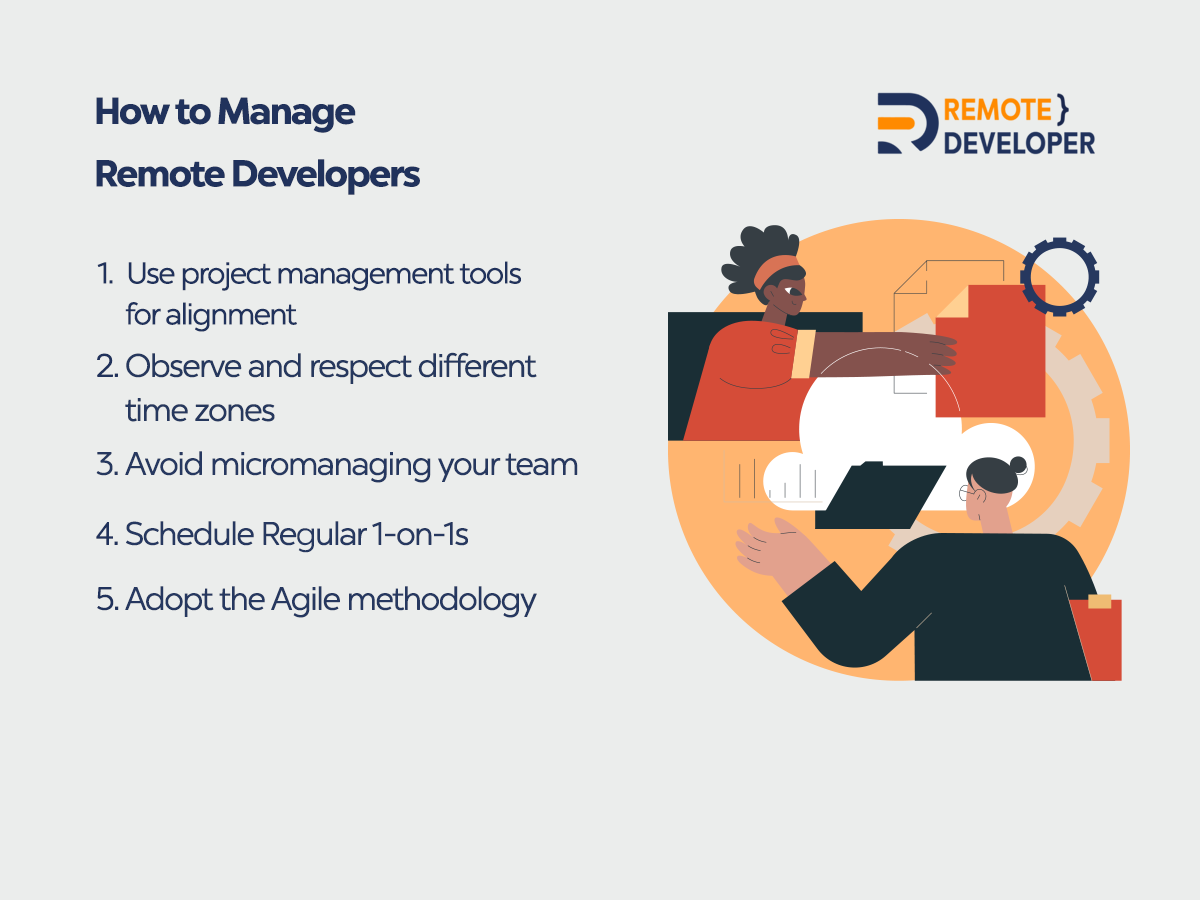Remote development teams are a common choice for software development projects because they allow developers to work from any location with internet access.
However, managing remote developers is not always easy, and there are several challenges that remote teams must contend with. These include ensuring that all team members are productive and communicating effectively. In addition, project managers need to be able to manage the team’s schedule and resources, and ensure that everyone is working on the same project.
There is no one-size-fits-all answer to the question, “how to manage remote developers,” as the best way to manage a remote development team will vary based on the size, structure, and culture of the team.
Some tips on how to manage a remote development team include setting clear expectations and goals for each person on the team, establishing communication channels, providing quality assurance checks, and setting up tracking mechanisms.
Let’s take a look at each one to see how you can better set your remote team up for success.
Use project management tools for alignment
Managing a remote development team can be difficult, especially when trying to set milestones. There are a few different project management tools that can help make this process easier. Jira and Trello are two of the most popular tools, and both offer ways to create milestones and track progress.
Jira is a tool designed for software development teams. It has features that allow you to track tasks and dependencies as well as create milestones. You can also use it to create reports on project progress.
Trello is a more lightweight tool that allows you to create cards representing tasks or milestones, and then move them between boards representing different stages of your project.
Project management tools are key to keeping everyone on track. By setting up the tools correctly and using them consistently, you can help ensure that your remote team is productive and stays on track.
Both Jira and Trello offer free versions, so you can try out each tool to see which one works best for you.
Observe and respect different time zones
One of the biggest challenges is respecting different time zones when working with a remote team. Here are a few tips for making sure everyone is on the same page:
- Choose a communication platform that works across time zones. Slack, Zoom, and Google Hangouts are all good options.
- Make sure everyone is aware of the time zone they’re working in and how it compares to other time zones. Use a time-tracking app like Toggl so that everyone is on the same page about what time it is where they are.
- Use scheduling tools like Calendly or Doodle to schedule calls and meetings. This will help avoid any confusion about when things are happening.
- Avoid scheduling conference calls or meetings during times when someone’s location is significantly ahead or behind yours.
- Be mindful of the hours that people are typically available in their respective time zones.
- Communicate clearly about deadlines and expectations, and make sure everyone is aware of when things need to be done in order to meet them.

Avoid micromanaging your team
Micromanagement can have a negative effect on remote developers. When managers micromanage, they often send unnecessary and unwanted emails, make frequent phone calls, and require excessive status updates. This can lead to remote developers feeling overwhelmed and stressed, which can, in turn, lead to them becoming less productive.
Additionally, micromanagement can damage relationships between team members and create an atmosphere of distrust. Because of this, it’s important for managers of remote teams to know the risks of micromanagement and take steps to avoid it.
One way to avoid micromanagement is to set clear expectations from the beginning. Make sure your developers understand what you want and how you want it done.
Give your developers the freedom to work independently. Let them know that you trust their judgment and will not hover over them constantly.
Finally, be available for questions and feedback, but don’t take over the project yourself. Let your developers do their job, and step in only if absolutely necessary.
Schedule Regular 1-on-1s
When working with a remote development team, it is important to remember that they are people, too. They have feelings and opinions that should be taken into consideration.
Giving and receiving feedback can be the key to keeping remote developers on track and ensuring that the project is moving in the right direction.
To schedule regular feedback, you should block out specific time slots on your calendar for 1-on-1 meetings with your remote developers.
During these meetings, you should ask them about their progress on the project, and any issues they’ve run into, and give them feedback on their work.
You can also use these 1-on-1 meetings to discuss future goals for the project and make sure everyone is on the same page.
By setting up these meetings on a regular basis, you’ll be able to find out how your team feels, how they like to work, and how to improve the workflow.
Adopt the Agile methodology
The Agile methodology has revolutionized the way software is developed and is considered the best practice for software development. This framework lets developers respond quickly to changes, makes it easier for team members to talk to each other, and encourages them to work together.
Developers who use this methodology can quickly adapt to changes in requirements. This is due to the fact that Agile is a flexible methodology that allows for incremental development and constant feedback from stakeholders. As a result, projects are able to adapt more easily to changing requirements and deadlines.
The Agile framework consists of short cycles called “sprints,” which allow team members to communicate frequently and effectively. As a result, team members are able to work together more collaboratively and efficiently.
In order to make the most out of agile when working with a remote team, you need to keep in mind a few key things:
- Adapt the agile framework according to your team’s specific situation and needs. There is no one-size-fits-all solution, so do not be afraid to experiment until you find what works best for you.
- Promote transparency and communication within the team. This is especially important when working with remote developers, as communication can be more difficult due to the lack of face-to-face interaction. Make sure that everyone is kept up-to-date on progress and issues, and that all stakeholders have access to the same information.
The Bottom Line
Managing a remote development team is not without its challenges, but with the right tools and processes in place, it can be a successful and productive way to work. Set clear goals, make sure everyone knows how to communicate, and use the right tools to help your remote team work together smoothly and effectively.
To learn more about how to create a productive remote working environment, contact us today!

